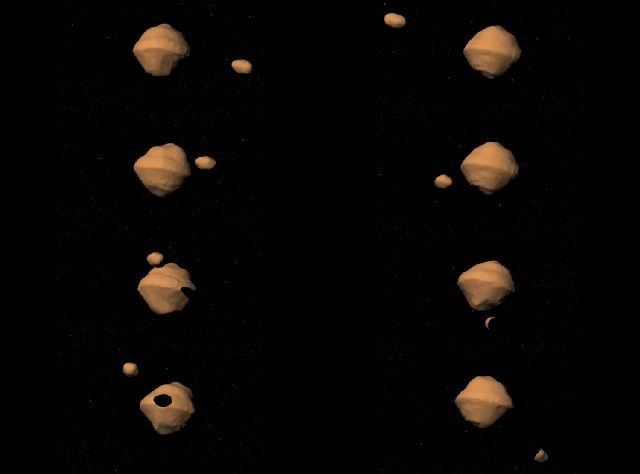
A large asteroid that has its own tiny companion moon is set to whiz past Earth this weekend.
The so-called binary asteroid, known as 1999 KW4, will make its closest approach at 7:05 p.m. ET on May 25, when it will be roughly 3.2 million miles from Earth—a safe distance but relatively paltry in space terms, NBC News reported. For context, this figure is about 13.5 times the distance between the Earth and the moon.
According to NASA's Center for Near-Earth Object Studies, 1999 KW4 will speed past Earth at around 48,000 miles per hour. The main object, shaped like a spinning top with a pronounced ridge around its equator, is estimated to measure around 0.8 miles in diameter. The small moon, which orbits at a distance of 1.6 miles every 16 hours, is thought to be around the third of that size, EarthSky reported.
1999 KW4 was first discovered in 1999 by the Lincoln Near-Earth Asteroid Research program in New Mexico. Since then, it has been extensively tracked and studied by astronomers. In fact, the object will be closely watched during its latest close approach by scientists at various observatories as part of an international effort to protect Earth from future catastrophic asteroid strikes.
"It's one of the closest binary flybys probably in recent history," Vishnu Reddy, a planetary scientist at the University of Arizona in Tucson, told NBC News. "That's what makes it a very interesting target."
1999 KW4 has been classified as a Near Earth Object (NEO), a term that refers to any asteroid or comet whose orbit takes it within 121 million miles of the sun, as well as within approximately 30 million miles of Earth.
It has also been defined as a "potentially hazardous object," meaning any NEO that has a (typically small) chance of colliding with Earth—i.e., the predicted minimum approach distance is less than 4.6 million miles—and is greater than 460 feet in diameter.
According to EarthSky, 1999 KW4 is the largest space rock that will come this close to our planet until June 2027, when asteroid 4953 (1990 MU), which is estimated to measure at least 2.5 miles in diameter, will sail past the Earth.
Currently, researchers know of more than 18,000 NEOs, of which over 1,800 are considered potentially hazardous. While there are a handful of potentially hazardous objects that are predicted to have a small chance of colliding with Earth in tens to hundreds of years, the odds will likely fall as monitoring stations make more observations, enabling more accurate predictions of their trajectories.
Uncommon Knowledge
Newsweek is committed to challenging conventional wisdom and finding connections in the search for common ground.
Newsweek is committed to challenging conventional wisdom and finding connections in the search for common ground.
About the writer
Aristos is a Newsweek science reporter with the London, U.K., bureau. He reports on science and health topics, including; animal, ... Read more
To read how Newsweek uses AI as a newsroom tool, Click here.








